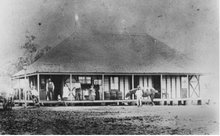Having spent the Easter long weekend visiting relatives I found myself musing on some of the similarities and differences between two towns whose populations share a migrant past. Stanthorpe in the Granite Belt is an interesting contrast to Marburg. Marburg’s German migrants mostly arrived in the late 1800s. Stanthorpe’s Italian population were post-World War Two arrivals. What they have in common is that both populations have been in Australia long enough to have little to differentiate them from the general population other than their names. However, Stanthorpe still has the more overt markers of migration – a few Italian shops, the International Club, makers of bulk Italian wines and the Italian choir amongst others. Many families still have Italian-speaking elders. A few even have grandparents living with them who don’t speak any English.
I’ve been visiting Stanthorpe for about eighteen years now and have noticed a decline in its overtly Italian identity. When I first visited, my in-laws could walk down the main street in town pretty much only speaking Italian. Now, there are very few Italian speakers on the street. Many of the shopkeepers were Italian: the Mattiazzis, Girgentis and so on. Then the chaotic, overflowing and fascinating Mattiazzi’s Italian Deli became the upmarket Samuel’s Fine Foods, which then morphed into the trendy kitchenware and deli, Olga and Agnes. While change may occur, people are still very proud of their Italian heritage. And gelato, parmesan and espresso are part of mainstream Australian food culture now.
Part of this continuing heritage is that Italian culture is so closely tied to the Catholic church. Stanthorpe has a large and prosperous Catholic congregation. Festivals like those of the “Three Saints” are celebrated with parades and food and the church has Italian food stands at such local festivities as the Apple and Grape Festival. Some of the more successful orchardists and farmers are both Italian and prominent members of the Catholic church.
However, I can see Stanthorpe in a few decades retaining only vestiges of its Italian heritage. Right now, relative prosperity and religious affiliations are maintaining a cultural identity for the town in a way that Marburg’s subdued German Lutheranism does not. As someone asked me recently, “What German heritage does Marburg have other than German street names?”
Tuesday, 25 March 2008
Migration musings
Labels:
cultural difference,
German migrants,
heritage,
Marburg,
migrants,
Stanthorpe
Subscribe to:
Post Comments (Atom)

1 comment:
Hello Blithe
I think that I am the "someone" who posed the question regarding Marburg's supposed German heritage. The issue arose for me again at a meeting I attended last week where the discussion was about holding a festival to celebrate the district's German heritage. I ask, "What German heritage?" There is no doubt that German migrants settled in this area, but so also did English and Irish migrants - and there is plenty of evidence of this in the local cemetries. If the town had been given an Irish name instead of its German one, we would be talking about our Irish heritage. To the best of my knowledge, the only German street name in town is Frederick Street. All of the others are very English.
Your inquistive, curmudgeonly neighbour
Your
Post a Comment